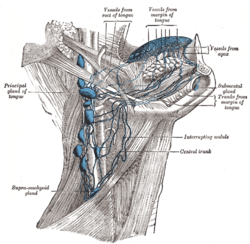Jugulodigastric lymph node
Appearance
| Jugulodigastric lymph node | |
|---|---|
 Jugulodigastric are numbered 9 (at top):
| |
 Lymphatics of the tongue. (Jugulodigastric lymph node visible but not labeled.) | |
| Details | |
| System | Lymphatic system |
| Identifiers | |
| Latin | nodus lymphoideus jugulodigastricus |
| Anatomical terminology | |
The jugulodigastric lymph nodes are large lymph nodes of the neck.
Structure
The jugulodigastric lymph nodes are found in the proximity of where the posterior belly of the digastric muscle crosses the internal jugular vein. Nodes are typically around 15 mm in length in adults, and decrease in size during old age.[1] They tend to be some of the largest lymph nodes in the cervical chain due to their significant lymphatic drainage.[1]
Function
The jugulodigastric lymph nodes are the first to receive lymphatic drainage from face, mouth, pharynx, and tonsils.[1]
Clinical significance
Enlarged tender jugulodigastric nodes, if accompanying exudative pharyngitis, is likely to be of Streptococcal etiology.[2] Enlarged jugulodigastric lymph nodes are also commonly found in tonsillitis.
References
- ^ a b c Costa e Silva Souza, Leticia M.B.; Leung, Katherine J.; O'Neill, Anne; Jayender, Jagadeesan; Lee, Thomas C. (January 2018). "Jugulodigastric lymph node size by age on CT in an adult cancer-free population". Clinical Imaging. 47: 30–33. doi:10.1016/j.clinimag.2017.07.013. ISSN 0899-7071.
- ^ Worzala, Katherine; Dale Berg (2006). Atlas of adult physical diagnosis. Hagerstown, MD: Lippincott Williams & Wilkins. pp. 28. ISBN 0-7817-4190-4.
